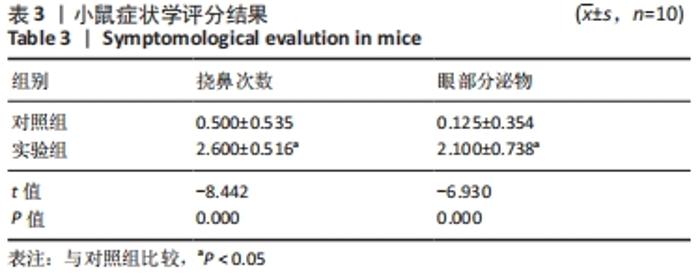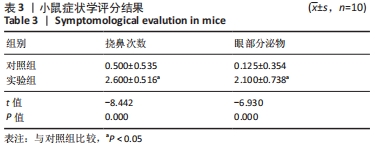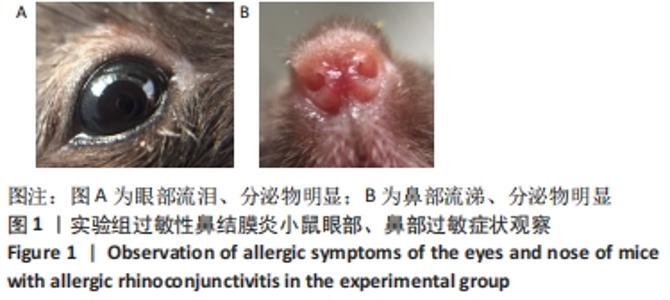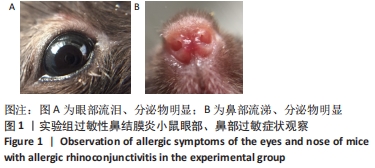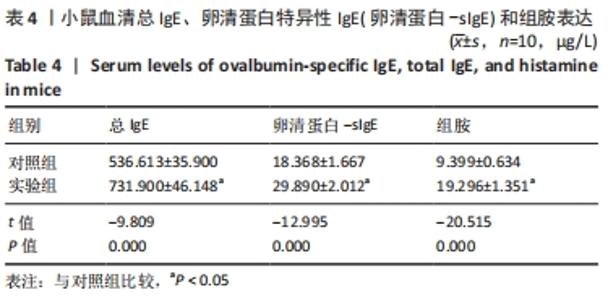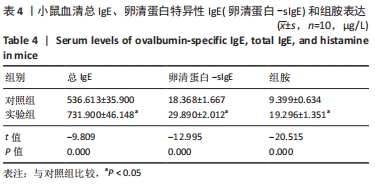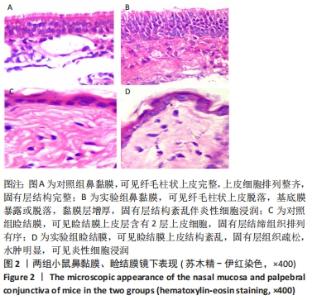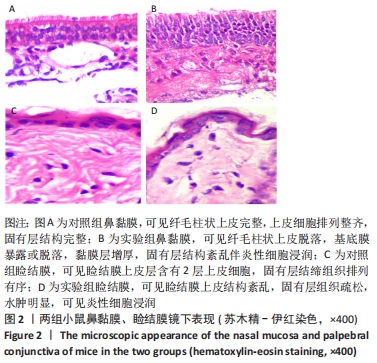[1] 徐黄杰,宋剑涛,高健生.过敏性鼻结膜炎目鼻同治的研究进展[J].中国中医眼科杂志,2014,24(3):223-226.
[2] CIPRANDI G, LEONARDI S, ZICARI AM, et al.Allergic rhinoconjunctivitis: pathophysiological mechanism and new therapeutic approach. Acta Biomed. 2020;91(1):93-96.
[3] 宋剑涛,沈志华,高健生,等.川椒方对过敏性结膜炎小鼠IL4-JAK1-STAT6信号通路的影响[J].中国中医眼科杂志,2013,23(4):240-243.
[4] KUO CH, COLLINS AM, BOETTNER DR, et al. Role of CCL7 in Type I Hypersensitivity Reactions in Murine Experimental Allergic Conjunctivitis. J Immunol.2017;198(2):645-656.
[5] SHIN SH, YE MK. The effect of nano-silver on allergic rhinitis model in mice. Clin Exp Otorhinolaryngol. 2012;5(4):222-227.
[6] 杨军,王敏,张罗.细胞因子和免疫球蛋白抗体在过敏性鼻炎小鼠早期无症状阶段和晚期有症状阶段表达的差异[J].首都医科大学学报,2018,39(1):63-68.
[7] 白梦天,胡竹林.过敏性疾病小鼠动物模型建立及表型变化的研究进展[J].中国比较医学杂志,2020,30(2):128-134.
[8] 王颖. 建立不同剂量OVA滴鼻过敏性鼻炎模型及相关机制研究[D].武汉:华中科技大学,2019.
[9] 李素毅,高健生,接传红,等.川椒方治疗小鼠变应性结膜炎的实验研究[J].世界中医药,2012,7(3):263-265.
[10] BARTRA J, MULLOL J, MONTORO J, et al. Effect of bilastine upon the ocular symptoms of allergic rhinoconjunctivitis. J Investig Allergol Clin Immunol. 2011;Suppl 3:24-33.
[11] 向浏岚,叶远航,蒋璐云,等.Tim-3在变应性鼻炎中的作用及机制研究进展[J]. 山东大学耳鼻喉眼学报,2020,34(6):118-122.
[12] TANG J, XIAO P, LUO X, et al.Increased IL-22 level in allergic rhinitis significantly correlates with clinical severity. Am J Rhinol Allergy. 2014; 28(6):197-201.
[13] 廖东,付明亮,高小丹,等.Notch信号途径对过敏性鼻炎小鼠Treg/Th17细胞免疫失衡调节的机制[J].贵州医科大学学报,2020, 45(10):1176-1181+1186.
[14] 陈俊曦,黄东辉,左晓晖,等.黄芪桂枝五物汤加味对变应性鼻炎大鼠Th1/Th2和Th17/Treg细胞免疫失衡的调节作用[J].广州中医药大学学报,2020,37(7):1327-1331.
[15] KONRADSEN J, ARVIDSSON M. Allergenspecifik immunterapi ger långvarig symtomlindring - Ändå är behandlingen inte tillgänglig för alla patienter som behöver den [Allergen-specific immunotherapy provides long-lasting symptom relief. Lakartidningen. 2016;113:DW74.
[16] ASAKA D, YOSHIKAWA M, NAKAYAMA T, et al. Elevated levels of interleukin-33 in the nasal secretions of patients with allergic rhinitis. Int Arch Allergy Immunol. 2012;Suppl 1:47-50.
[17] WANG X, HU G, KANG H, et al. Increased IL-19 level in peripheral blood of patients with allergic rhinitis is related with clinical severity. Xi Bao Yu Fen Zi Mian Yi Xue Za Zhi. 2015;31(11):1537-1540,1543.
[18] 李亚梅,邹昊宇,胡鸿运,等.夏枯草水提物对过敏性结膜炎大鼠NLRP3/Caspase1/IL-1β通路的影响[J].中国新药杂志,2020,29(8): 928-933.
[19] PALOMARES O, AKDIS M, MARTÍN-FONTECHA M, et al. Mechanisms of immune regulation in allergic diseases: the role of regulatory T and B cells. Immunol Rev. 2017;278(1):219-236.
[20] 高晓葳. 神经源性炎症反应在过敏性鼻结膜炎鼻眼之间相互作用的研究[D].天津:天津医科大学,2019.
[21] HESSELMAR B, ABERG B, ERIKSSON B, et al. Allergic rhinoconjunctivitis, eczema, and sensitization in two areas with differing climates. Pediatr Allergy Immunol. 2001;12(4):208-215.
[22] 马群,曾水清,乔彤,等.儿童过敏性结膜炎和过敏性鼻炎的关系[J].临床眼科杂志,2009,17(3):216-219.
[23] TOIZUMI M, HASHIZUME M, NGUYEN HAT, et al. Asthma, Rhinoconjunctivitis, Eczema, and the Association with Perinatal Anthropometric Factors in Vietnamese Children. Sci Rep. 2019;9(1): 2655.
[24] JALBERT I, GOLEBIOWSKI B. Environmental aeroallergens and allergic rhino-conjunctivitis. Curr Opin Allergy Clin Immunol. 2015;15(5):476-481.
[25] MIYAZAKI D, FUKAGAWA K, OKAMOTO S, et al. Epidemiological aspects of allergic conjunctivitis. Allergol Int. 2020;69(4):487-495.
[26] PERKIN MR, BADER T, RUDNICKA AR, et al. Inter-Relationship between Rhinitis and Conjunctivitis in Allergic Rhinoconjunctivitis and Associated Risk Factors in Rural UK Children. PLoS One. 2015;10(11):e0143651.
[27] GERALDES L, MORGADO J, ALMEIDA A, et al. Expression patterns of HLA-DR+ or HLA-DR- on CD4+/CD25++/CD127low regulatory T cells in patients with allergy. J Investig Allergol Clin Immunol. 2010;20(3): 201-209.
[28] SINGH S, SHARMA BB, SALVI S, et al. Allergic rhinitis, rhinoconjunctivitis, and eczema: prevalence and associated factors in children. Clin Respir J.2018;12(2):547-556.
[29] NEERVEN RJJV, SAVELKOUL H. Nutrition and Allergic Diseases. Nutrients. 2017;9(7):762.
[30] YAU JW, HOU J, TSUI SKW, et al. Characterization of ocular and nasopharyngeal microbiome in allergic rhinoconjunctivitis. Pediatr Allergy Immunol. 2019;30(6):624-631.
|
